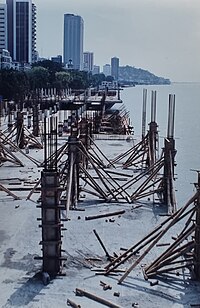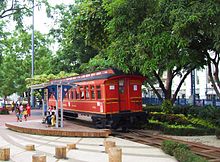Malecon 2000


Malecón 2000, located in the city of Guayaquil, next to the Guayas River, is an urban regeneration project of the old Malecón Simón Bolívar, 2.5 km long where you can enjoy the great monuments of the history of Guayaquil, such as the Hemiciclo de la Rotonda, Palacio de Cristal, MAAC, gardens, fountains, shopping center, restaurants, bars, food courts, the first IMAX cinema in South America, as well as docks, from where you can board boats to take day and night rides along the Guayas River and viewpoints among other attractions.
It constitutes one of the largest works undertaken by the city of Guayaquil and is considered a model worldwide, in addition to having been declared 'healthy public space' by the Pan American Health Organization/World Health Organization (PAHO/WHO).
History
The Malecón 2000 is part of the history of Guayaquil. The city built on a territory with difficult characteristics due to the adverse conditions it presented, its realization was considered an adventure for the inhabitants of that time.
Its history dates back to before 1820, when it was called Calle de la Orilla. By 1845 it was a mile and a half long with slatted seats and cast iron lamps to illuminate it. In 1906 the Cabildo built its retaining wall, between the Las Peñas neighborhood and Colón Street, where the missing La Orilla Market was located.
Traditionally, it was the first image of the city for travelers arriving by boat, since at that time the waterway was the main means of communication. The 1920 modifications are modeled on the "lungomare" of some Italian cities. Initially, the sector between Aguirre and Junín streets was called Paseo de las Colonias Extranjeras, thanks to a Municipal Ordinance of 1931. Later its name changed to Malecón Simón Bolívar and in 1999 it was one of the most visited places.

Starting in 1999, the remodeling of the Malecón Simón Bolívar, begun in the administration of Mayor León Febres-Cordero Ribadeneyra, former president of the Republic of Ecuador, had as its purpose, from the beginning of its conception, the revaluation of the commercial center of the city of Guayaquil, creating spaces that foster urban regeneration, a purpose that has been fulfilled thanks to the decision of its Leaders, both from the public and private sectors, who believed in the feasibility of what is now a great reality that receives the visit of nationals and foreigners who admire and enjoy the security and beauty conferred by one of the most visited places in the city with approximately 95 million visits since the inauguration of the first stage in October 1999, its current president, lawyer Jaime Nebot. Saadi, mayor of the city, who has decisively managed to complete this work that makes all Ecuadorians proud and is a reference for Guayaquil.
The Malecón 2000 is a public place where the visitor can carry out multiple activities alone or with the family. It is a tourist circuit that combines modern architecture with historical legacies, nature and the romantic natural setting provided by the Guayas River. They have allowed the common citizen to take ownership of each space that forms it and therefore take care of it and teach others that the Malecón 2000 belongs to the city.
The Malecón is a historical pillar of the city, since its growth expanded from it and at the beginning of the city it played an important role in its development and beautification. Then, at one time, due to the imprudence of fate, he was separated from Guayaquil; But being what it was, it was rescued and renovated, giving a new shine to the city. It is one of the most beautiful works in Guayaquil.
Now it is an honor for Guayaquil residents to be able to enjoy the colors of the Malecón and from it, those of the estuary. The Malecón 2000 has once again been the heart of the city and wants to share with all its guests the wonder of its landscape. You cannot stop visiting Guayaquil without getting to know it for the first time or again.
It is divided into sectors, the same ones that show the variety of the greatness of Guayaquil, each of them with a different color. Thus, at the beginning it shows the diversity of Ecuadorian flags with a contrasting color, so that the “Crystal Palace” can simply show its imposing look.
Children's play and recreation areas

This area was created for the recreation of the inhabitants of the area, but can be enjoyed by visitors from any region. There is entertainment for everyone, with games for children, rest areas, exercise, and restaurants and bars.
In the children's recreation area, there is a set of recreational circuits for the little ones who visit the Malecón 2000 accompanied by their parents, including the Plaza del Vagón and rest areas under the shade of trees that have been preserved. of the previous pier.
The play area has a viewing tower, slide, slides, hanging bridges, hammocks, carousels and other games that encourage children to have healthy fun in a quiet and safe place. A skating rink has also been designed.
The food area has two buildings: the first contains a fast food establishment on its upper floor and general toilet services on its ground floor for the public visiting the area, the second building is the bar-restaurant.
The exercise area is equipped with equipment for aerobics and outdoor exercises and is a meeting place for people who jog early every day on the Malecón 2000.
Malecón Gardens

This section of the Malecón 2000 is undoubtedly one of the most beautiful and colorful, because in addition to having squares and small squares created to complement the beauty that nature confers, you can see the diversity of more than 350 native plant species and the that have been introduced into the country.
In this place is the Donor Pavilion which is a recognition of the voluntary donations received to carry out this work. According to the order of succession in which these were made, the name of the approximately 48,400 natural and legal donors can be located through a computerized system that locates the plate and the row number in which the donor is located. The pavilion is illuminated to highlight the 32 tempered glass plates on which the names are carved. As the background of this unique gift, is Cerro Santa Ana with its renewed color.
Next to the Pavilion, the IMAX-Malecón Theater is the first of its kind in South America. A dome with the highest technology in large format film projection, exclusive to IMAX Corporation, capturing the attention of adults and children who visit the Malecón 2000 eager to live the IMAX Experience, in its 185 seats with an audio and video system high definition.
Monuments
- Abel Romeo Castillo.
- Hemiciclo de la Rotonda.
- October 9 Obelisk.
- Leon Febres Cordero.
- Vicente Lecuna.
- Bartolome Salom.
- Alfredo Baquerizo Moreno.
- Carlos Alberto Arroyo del Río.
- José Joaquín de Olmedo.
Concurrency
The Malecón 2000 is the most visited site in Guayaquil, with an average of 1.6 million people per month, a figure that reaches 3.4 million during the patron saint festival season.
Contenido relacionado
Cross port
New seven wonders of the modern world
Prague
Acropolis of athens
Hato Mayor Province